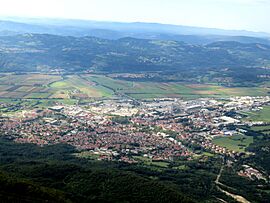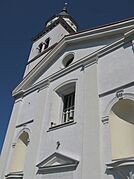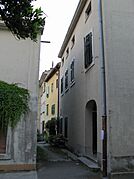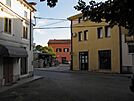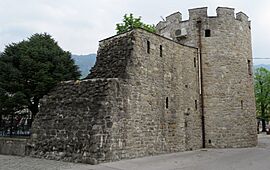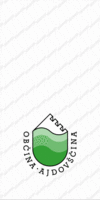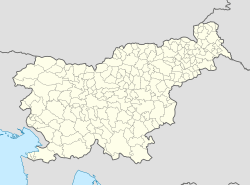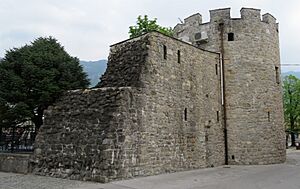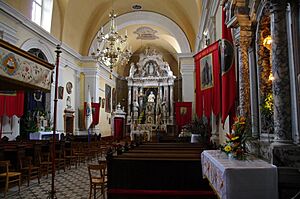Ajdovščina facts for kids
Quick facts for kids
Ajdovščina
|
|||
|---|---|---|---|
|
Town
|
|||
|
From top, left to right: Ajdovščina from above, Holy Cross Church, Old alley, Old ironworks, Houses in the center, Roman Castra Fort
|
|||
|
|||
| Country | |||
| Traditional region | Littoral | ||
| Statistical region | Gorizia | ||
| Municipality | Ajdovščina | ||
| Area | |||
| • Total | 7.0 km2 (2.7 sq mi) | ||
| Elevation | 106 m (348 ft) | ||
| Population
(2020)
|
|||
| • Total | 6,843 | ||
| • Density | 943/km2 (2,440/sq mi) | ||
| Vehicle registration | GO | ||
| Climate | Cfa | ||
Ajdovščina is a town in the Vipava Valley in Slovenia. It is the main town and administrative center of the Municipality of Ajdovščina.
Contents
History of Ajdovščina
Ajdovščina has a very long history, with the first mentions of the area going back to about 2000 BC. During the Bronze Age and Iron Age, a strong settlement stood on a nearby hill called Gradišče.
Roman Times in Ajdovščina
In the early days of the Roman Empire, a small station for travelers and goods was built here. It was called mansio Fluvio Frigido. This happened after the Romans built an important road connecting Aquileia and Emona (modern-day Ljubljana).
Later, around the late 200s and early 300s AD, the Roman Empire built a huge defense system. This system was called Claustra Alpium Iuliarum. It stretched from the Kvarner Gulf all the way to Cividale. The most important part of this defense was the fortress of Castra. You can still see parts of this ancient Roman fort in Ajdovščina today.
Ajdovščina's Unique Architecture
Ajdovščina is less than 20 kilometers from the Italian border. It was even under Italian control from 1918 to 1947. However, the town does not look like a typical Italian town. This is because of the strong bora winds that blow through the area.
These powerful winds would damage regular Italian houses. So, the people of Ajdovščina changed their building style. They used the traditional Karst architecture, adding heavy stones on roofs. This helped to hold down the tiles against the strong winds.
Modern Ajdovščina
After World War II, Ajdovščina became a very important center for business and culture in the upper Vipava Valley. Some of the main industries here include making textiles, construction, food, drinks, and furniture. In 1953, Ajdovščina grew bigger by adding the nearby settlements of Gradišče and Šturje.
Geography and Climate of Ajdovščina
The Hubelj River divides Ajdovščina into two main parts: Šturje and Ajdovščina. Before World War I, this river was also the border between two Austrian regions: Gorizia and Gradisca, and Carniola.
The town has a Mediterranean climate. This means winters are mild, with temperatures usually between -1°C and 17°C. Summers are warm, with temperatures ranging from 20°C to 39°C. Ajdovščina is located about 25 kilometers away from the Adriatic Sea.
Landmarks in Ajdovščina
Ajdovščina has several important churches.
Churches in Ajdovščina
The main church in Ajdovščina is dedicated to John the Baptist. It is part of the Diocese of Koper. This church was built on the site of an old Roman cemetery. A local Baroque painter named Anton Čebej painted the inside of the church.
There is also another church area within Ajdovščina called the Parish of Šturje. Its main church is dedicated to Saint George. Another church in this parish is dedicated to Saint Lawrence. In the small village of Fužine, just north of the town, there is a church dedicated to Saint Anthony of Padua. This church also belongs to the Parish of Šturje.
Notable People from Ajdovščina
Many interesting people have come from Ajdovščina. Here are a few:
- Ivo Boscarol (born 1957), a successful businessman.
- Arthur Casagrande (1902–1981), an important engineer.
- Anton Čebej (1722–1774), a famous painter.
- Miša Cigoj (born 1982), a talented dancesport athlete.
- Milan Klemenčič (1875–1957), a well-known puppeteer.
- Karel Lavrič (1818–1876), a politician.
- Danilo Lokar (1892–1989), an author.
- Julij Mayer (1891–1983), a beekeeper.
- Veno Pilon (1896–1970), a painter.
- Avgust Žigon (1877–1941), a historian who studied literature.
See Also
 In Spanish: Ajdovščina para niños
In Spanish: Ajdovščina para niños


